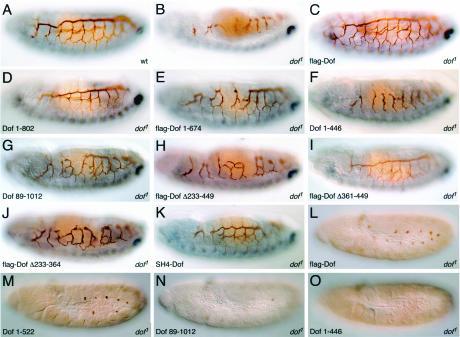FIG. 2.
Abilities of different mutant Dof proteins to rescue defects in the development of the mesoderm and tracheae. (A to K) Tubular network of the tracheae, revealed using the monoclonal antibody 2A12, is shown in brown. Even-skipped, visualized as a blue stain, was used to identify the homozygous mutant embryos by the absence of pericardial cells expressing Eve in the mesoderm, which can be seen in the wild-type embryo in panel A as a dorsal row of faint out-of-focus spots. (A) Stage 15 wild-type embryo; (B) homozygous dof1 mutant embryo. (C to K). Tracheal development of homozygous dof1 mutant embryos in which mutant forms of Dof were overexpressed using a btl-Gal4 transgene. The embryos chosen for flag-Dof[1-674] (E), Dof[1-446] (F), Dof[89-1012] (G), flag-Dof[Δ361-449] (I), and SH4-Dof (K) show the typical rescues obtained with these constructs, while those chosen for flag-Dof[Δ233-449] (H) and flag-Dof[Δ233-364] (J) show the best rescue of tracheal development obtained with these constructs. (L to O) Abilities of the mutant Dof proteins flag-Dof (L), Dof[1-522] (M), Dof[89-1012] (N), and Dof[1-446] (O) to promote differentiation of the mesoderm in stage 11 embryos were determined by monitoring the expression of Even-skipped, shown in brown, in parasegments 3 to 13. The embryos shown are representative, although a large degree of variation in the number of Even-skipped positive clusters was observed for the mutant Dof[89-1012].

